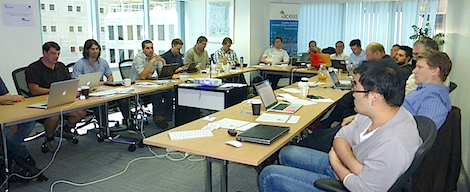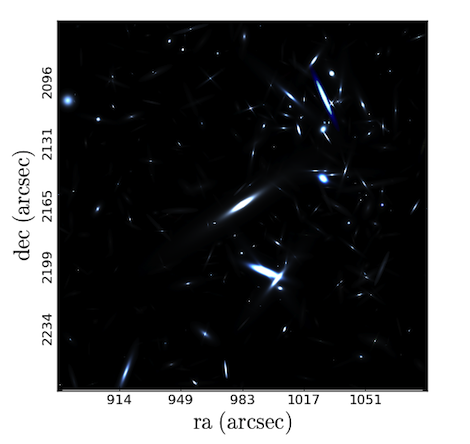A Chief Operating Officer for Intersect
Marc Bailey has signed on as Intersect’s Chief Operating Officer, joining us from his role as CIO at Macquarie University.
Intersect CEO Dr Ian Gibson said, “Intersect is extremely fortunate to have secured Marc’s service as we take the organisation into its next stage of its development, and we look forward to working closely together”.
“I am excited and privileged to team up with Intersect’s management team and distinguished Board in its mission to enable next generation research and innovation”, commented Bailey. “I very much look forward to bringing entrepreneurial passion and commitment to growing Intersect’s eResearch contribution and impact”. Full story here.
Spatial scientists work on a next gen data visualisation tool
Intersect hosted a week long hackfest which brought together national teams to work on storing and serving Australian gridded datasets. The group created a new open source tool, called the Spatially Explicit Data Discovery, Extraction and Evaluation Service (SPEDDEXES).
The tool will allow web users (via a portal) to query, extract and visualise national spatial datasets. Participants included a mix of senior and developer representatives from TERN, the Bureau of Meteorology, National Computational Infrastructure, Geoscience Australia, CSIRO, IMOS, UNSW, University of Queensland, Macquarie University and Intersect.
The hackfest was coordinated by the Australian Centre for Ecological Analysis & Synthesis (ACEAS) and led by Bradley Evans of Macquarie University and Siddeswara Guru from UQ. Staff from Intersect also assisted.
The resulting tools and websites will be hosted by NCI and will be made publicly available.
More about the group’s activities can be found on the ACEAS web site. Read more…
All Sky Virtual Laboratory takes off
The Theoretical Astrophysical Observatory (TAO), has been launched by Swinburne University of Technology. Intersect worked closely with Swinburne on the project, designing the web interface amongst other things.
Funded by the Australian Government’s NeCTAR project, TAO is a free online astronomy virtual laboratory that allows scientists to build complex customised views of the Universe, from their own computer.
“TAO lets researchers take the data from massive cosmological simulations and map it onto an observer’s viewpoint, to test theories of how galaxies and stars form and evolve,” TAO project scientist, Swinburne Associate Professor Darren Croton, said.
“TAO makes it easy and efficient for any astronomer to create these virtual universes. It’s the culmination of years of effort that is now at the fingertips of scientists around the world. Using TAO it might take a few minutes to create a mock catalogue of galaxies, versus months or even years of development previously,” he said. More on this story.
TAO acknowledges support from the NeCTAR project which is funded by the Australian Government through its Super Science initiative and financed by the Education Investment Fund.
POSSUM project on the go
Intersect has begun another great tablet based project in the health and medical research space. POSSUM stands for Precise Observational System for the Safe Use of Medications.
The POSSUM study aims to:
- adapt and test an observational method for measuring medication administration errors suitable for use in Australian hospitals.
- compare the type, rates and severity of medication administration error rates before and after various interventions.
- assess whether interruptions and multi tasking impact on medication administration errors rates.
(POSSUM) is being developed for the Centre for Health Systems and Safety Research, Faculty of Medicine, UNSW.
NeCTAR Research Cloud forecast
Intersect’s submission of NeCTAR architecture has been approved and we are proceeding with procurement. Our target for an active node remains Q3.
The NeCTAR Research Cloud will expand in 2014 with more research cloud nodes joining the federated effort and existing cloud nodes expanding their offerings. At the beginning of 2014, the NeCTAR research Cloud contained 6500 CPU cores contributed by research cloud nodes at the University of Melbourne, Monash University and the Queensland Cyber Infrastructure Foundation (QCIF).
The remainder of 2014 will see further significant growth with the number of CPU cores expected to treble to 30,000:
- Australian National University/NCI node: ~3200 CPU cores in Q1;
- QCIF Stage 2: ~3500 CPU cores in Q1;
- Monash University Stage 2: ~2000 CPU cores in Q2;
- University of Tasmania: ~3200 CPU cores in Q2;
- Intersect (NSW): ~4000 CPU cores in Q3;
- iVEC (Western Australia): ~4000 CPU cores in Q4.
NeCTAR is an Australian Government project conducted as part of the Super Science initiative and financed by the Education Investment Fund.
Infrastructure Update
The latest statistics from our RDSI node are:
- Total number of approved collections: 56
- TBs approved: 5143
- TBs provisioned: 740
- TBs ingested: 321
Intersect’s eResearch Analysts are the first point of contact for enquiries about our Research Data Storage node.
We are working to identify how to approve the data holdings of a large research centre, or the outputs of core facilities. We encourage the submission of more collections at this level.
Another key area is identifying collections for which the custodian is outside the membership of Intersect i.e. to identify research data to which researchers want access. We encourage researchers who know of data that they would like to use, but for which they don’t have access, to make contact with their university eResearch Analyst. This specifically includes data which is owned by state and federal government departments.
The Aspera file transfer tool has been rolled out as part of the Science DMZ deployment and is now in production. This allows us to maximise the use of our internet link for ingesting RDSI data collections. We are working with individual collection owners to facilitate the transfer of large data sets.
Training
The following training courses will occur in the near future:
- 28 – 29 Apr 2014: “Introduction to Unix for HPC” at UoN. Register at https://intersect-948.eventbrite.com.au/
- 1 May 2014: “Cleaning & exploring your data with Open Refine” at UoN. Register at https://intersect-952.eventbrite.com.au/
- 1 May 2014: “Data Visualisation with Google Fusion Tables” at UoN. Register at https://intersect-954.eventbrite.com.au/
- 9 May 2014: “Intersect – Cleaning & Exploring your data with Open Refine at Intersect. Please register at https://intersect-980.eventbrite.com.au
- 9 May 2014: “Intersect – Data Visualisation with Google Fusion Tables”at Intersect. Please register at https://intersect-981.eventbrite.com.au
- 9 – 10 July 2014: “Introduction to Unix for HPC” at UTS. Please register at https://intersect-982.eventbrite.com.au
- 11 July 2014: “Data Visualisation with Google Fusion Tables” at UTS. Please register at http://intersect-984.eventbrite.com.au
- 11 July 2014: “Cleaning & exploring your data with Open Refine” at UTS. Please register at http://intersect-986.eventbrite.com.au
For more information, see https://www.intersect.org.au/training
Grants
Intersect has assisted with more than 45 grant applications in Q1. Researchers are invited to contact their local eResearch Analyst for assistance in development of Data Management Plans and committing Intersect services as in-kind contributions to proposals.
Intersect is also coordinating a LIEF application for a large shared memory HPC cluster, led by Prof Marc Wilkins, UNSW.
New staff
Desiree Virgin is our new permanent Office Manager/ Executive Assistant.
Robyn Kirk is the new eResearch Analyst for Charles Sturt University.



